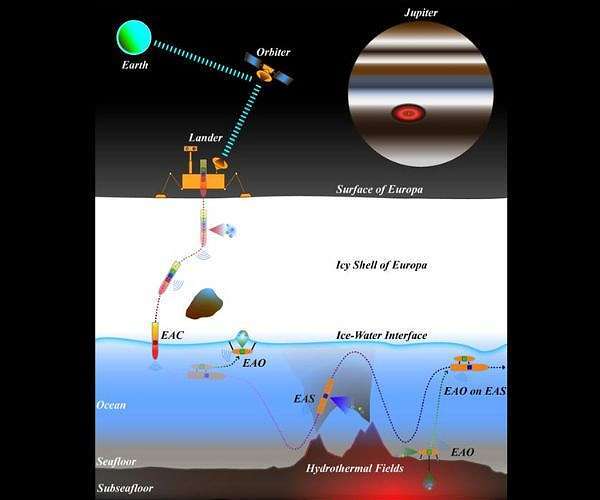6.01.2025

A Concept of Operations for Exo-AUV System (ConOps for MESA)
Icy moons like Europa and Enceladus offer intriguing environments for studying potential extraterrestrial life. These environments, particularly the icy shell, ice-water interface, and seafloor, are considered prime regions for identifying robust biosignatures, extant life, and prebiotic chemical systems. Extraterrestrial Autonomous Underwater Vehicles (Exo-AUVs) play a critical role in these explorations, performing autonomous, multidimensional detection to advance our understanding of these worlds.
For Europa, a key scientific goal in life detection missions is to explore its biological potential. This approach avoids binary frameworks and emphasizes detecting biosignatures and life-supporting conditions. By examining environmental variables akin to Earth's ecological theories, regions of high biological potential can be prioritized. Areas such as the icy shell, ice-water interface, and seafloor hold promise for yielding evidence of life. However, conventional biogenic analysis often misses strategies for collecting robust biosignatures. Sparse and heterogeneous life distributions in oligotrophic systems challenge both binary diagnosis and statistical methods in detecting biogenesis.
A comprehensive strategy for life detection involves four major steps: assuming, sampling, analyzing, and verifying. Leveraging ecological niche theory, Exo-AUVs are guided to identify micro-zones with high biological potential, collect diverse biosignatures, and potentially detect extant life. The Exo-AUV's capabilities allow for data collection that can validate or refine Earth-based models, providing a holistic methodology to explore life on icy worlds.
Europa presents unique challenges with its thick icy shell and deep under-ice oceans. Ice-penetrating carriers, powered by Small Modular Reactors (SMR) or Radioisotope Thermal Generators (RTG), can navigate these extreme conditions. Equipped with thermal-mechanical penetration systems and energy-efficient designs, they deploy Exo-AUVs to serve as mobile bases for navigation, data exchange, and recharging. Exo-AUVs, designed with advanced navigation and communication technologies, operate autonomously to explore and analyze the under-ice environments. Their payloads span disciplines such as acoustics, spectroscopy, molecular biology, and electrochemistry to address objects across scales from kilometers to micrometers.
Europa's distance from Earth imposes significant operational constraints, such as communication delays of up to 0.5 hours. This necessitates high autonomy in Exo-AUVs, enabling them to localize, navigate, and execute scientific tasks independently. They assess regions of biological potential, gather and analyze data, and update computational models for mission objectives.
A notable concept outlined is the Multi-Exo-AUV System (MEAS), consisting of an ice-penetrating carrier and specialized Exo-AUVs for surveying and observation. The system is optimized for Europa's diverse environments, with designs addressing weight, energy, and spatial constraints. Survey modules focus on large-scale exploration, while observation modules excel in analyzing localized zones. This distributed system increases efficiency, survivability, and adaptability to operational challenges.
Exo-AUV development in the U.S. and Europe highlights gaps in addressing the complexities of life detection on icy worlds. A conceptual roadmap for tailored Exo-AUV design emphasizes integrating science goals, contextual analysis, and refined technology to address Europa's unique challenges. The roadmap aims to ensure robust detection strategies, operational autonomy, and scalability for future missions.
The MEAS approach also facilitates the formation of a detection network for comprehensive exploration of Europa's global ice and ocean system. By addressing limitations in current Exo-AUV designs, this strategy supports the search for life across vast and varied environments.
Quelle: SD
